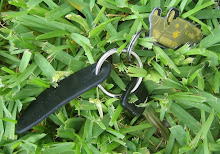Although Ptolemy VI (a Greek) began this structure, it looks like an Egyptian temple, except that the Greek (and later Roman) rulers were shown dressed as Pharaohs.
These conquerors worked with the local belief systems wherever they went, rather than pound the locals into their vision of the world.

Apparently Kom Ombo temple is the only place where there is a recording of the surgical instruments used at the time. With Imhotep the god of medicine and a series of reliefs depicting the various surgical tools, many of them similar to modern instruments.
 Here is a huge Nile meter to measure the height of the river. It was used to determine the level of taxes for the year.
Here is a huge Nile meter to measure the height of the river. It was used to determine the level of taxes for the year. Prisoners with toothed cartouches and missing faces. A cartouche is an oblong enclosure with a horizontal line at one end, indicating that the text enclosed is a royal name. It comes from the French word for a firearm's powder cartridge, as it was French soldiers who saw the shape and had so named it. Due to extreme heat, I do not remember why these cartouches are "toothed" or why the faces have been erased. Perhaps the faces were erased so that the people could not be recognized by their loved ones in the afterlife.
Prisoners with toothed cartouches and missing faces. A cartouche is an oblong enclosure with a horizontal line at one end, indicating that the text enclosed is a royal name. It comes from the French word for a firearm's powder cartridge, as it was French soldiers who saw the shape and had so named it. Due to extreme heat, I do not remember why these cartouches are "toothed" or why the faces have been erased. Perhaps the faces were erased so that the people could not be recognized by their loved ones in the afterlife. Mummified crocodiles.
Mummified crocodiles. Winged disc and eagle on the ceiling at the entrance to the temple.
Winged disc and eagle on the ceiling at the entrance to the temple. Joe shows she is not afraid of snakes.
Joe shows she is not afraid of snakes. Another mosque and minaret.
Another mosque and minaret. We're all waiting for the train to pass.
We're all waiting for the train to pass.
Next stop is the Temple of Edfu. The Temple of Edfu is an ancient Egyptian temple located on the west bank of the Nile in the city of Edfu. It is the second largest temple in Egypt after Karnak and one of the best preserved. The temple, dedicated to the falcon god Horus, was built in the Ptolemaic period between 237 and 57 BCE. The inscriptions on its walls provide important information on language, myth and religion during the Greco-Roman period in ancient Egypt.
 An early 20th century replica of a barque of Horus that would have sat in the Sanctuary. The barque would have been joined briefly each year by the barque of the goddess Hathor brought from Dendara Temple.
An early 20th century replica of a barque of Horus that would have sat in the Sanctuary. The barque would have been joined briefly each year by the barque of the goddess Hathor brought from Dendara Temple. Sky goddess "wrapped" around the ceiling.
Sky goddess "wrapped" around the ceiling. Drew wanders the narrow corridors.
Drew wanders the narrow corridors. Statue of Horus, the falcon god, in the courtyard of the temple.
Statue of Horus, the falcon god, in the courtyard of the temple.
The temple of Edfu fell into disuse as a religious monument following Theodosius I's edict banning non-Christian worship within the Roman Empire in 391 CE. As elsewhere, many of the temple's carved reliefs were razed by followers of the Christian faith which came to dominate Egypt. The blackened ceiling of the hypostyle hall, visible today, is believed to be the result of arson intended to destroy religious imagery that was now considered pagan. Or it could just have been blackened by smoke from fires used for cooking by Christians living inside the temple.
 Cool lighting effect.
Cool lighting effect. An example of the heavy security found throughout our travels in Egypt.
An example of the heavy security found throughout our travels in Egypt.

No comments:
Post a Comment